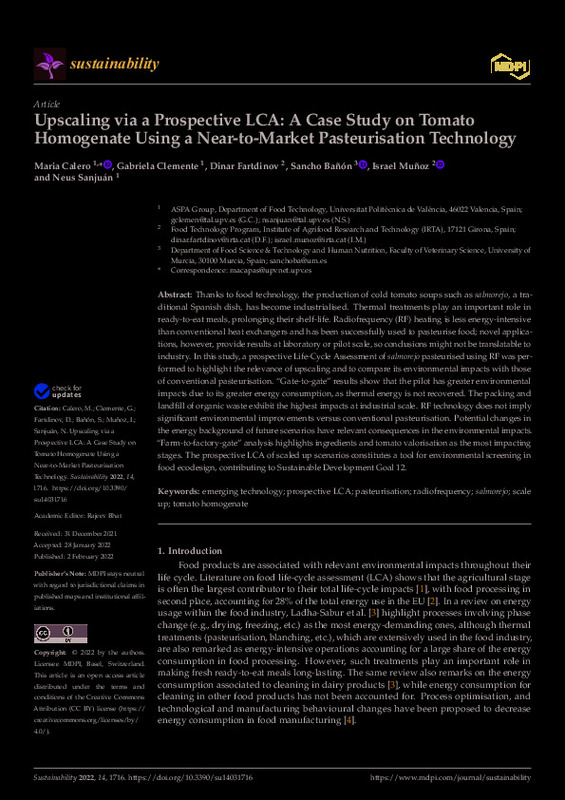JavaScript is disabled for your browser. Some features of this site may not work without it.
Buscar en RiuNet
Listar
Mi cuenta
Estadísticas
Ayuda RiuNet
Admin. UPV
Upscaling via a Prospective LCA: A Case Study on Tomato Homogenate Using a Near-to-Market Pasteurisation Technology
Mostrar el registro sencillo del ítem
Ficheros en el ítem
| dc.contributor.author | Calero, Maria
|
es_ES |
| dc.contributor.author | Clemente Polo, Gabriela
|
es_ES |
| dc.contributor.author | Fartdinov, Dinar
|
es_ES |
| dc.contributor.author | Bañón, Sancho
|
es_ES |
| dc.contributor.author | Muñoz, Israel
|
es_ES |
| dc.contributor.author | Sanjuán Pellicer, María Nieves
|
es_ES |
| dc.date.accessioned | 2023-06-08T18:01:00Z | |
| dc.date.available | 2023-06-08T18:01:00Z | |
| dc.date.issued | 2022-02 | es_ES |
| dc.identifier.uri | http://hdl.handle.net/10251/193995 | |
| dc.description.abstract | [EN] Thanks to food technology, the production of cold tomato soups such as salmorejo, a traditional Spanish dish, has become industrialised. Thermal treatments play an important role in ready-to-eat meals, prolonging their shelf-life. Radiofrequency (RF) heating is less energy-intensive than conventional heat exchangers and has been successfully used to pasteurise food; novel applications, however, provide results at laboratory or pilot scale, so conclusions might not be translatable to industry. In this study, a prospective Life-Cycle Assessment of salmorejo pasteurised using RF was performed to highlight the relevance of upscaling and to compare its environmental impacts with those of conventional pasteurisation. "Gate-to-gate" results show that the pilot has greater environmental impacts due to its greater energy consumption, as thermal energy is not recovered. The packing and landfill of organic waste exhibit the highest impacts at industrial scale. RF technology does not imply significant environmental improvements versus conventional pasteurisation. Potential changes in the energy background of future scenarios have relevant consequences in the environmental impacts. "Farm-to-factory-gate" analysis highlights ingredients and tomato valorisation as the most impacting stages. The prospective LCA of scaled up scenarios constitutes a tool for environmental screening in food ecodesign, contributing to Sustainable Development Goal 12. | es_ES |
| dc.description.sponsorship | This study was funded by the Spanish Ministry of Science, Innovation and Universities through the project RF-SUSVEG (RTI2018-098052-R-C31). | es_ES |
| dc.language | Inglés | es_ES |
| dc.publisher | MDPI AG | es_ES |
| dc.relation.ispartof | Sustainability | es_ES |
| dc.rights | Reconocimiento (by) | es_ES |
| dc.subject | Emerging technology | es_ES |
| dc.subject | Prospective LCA | es_ES |
| dc.subject | Pasteurisation | es_ES |
| dc.subject | Radiofrequency | es_ES |
| dc.subject | Salmorejo | es_ES |
| dc.subject | Scale up | es_ES |
| dc.subject | Tomato homogenate | es_ES |
| dc.subject.classification | TECNOLOGIA DE ALIMENTOS | es_ES |
| dc.title | Upscaling via a Prospective LCA: A Case Study on Tomato Homogenate Using a Near-to-Market Pasteurisation Technology | es_ES |
| dc.type | Artículo | es_ES |
| dc.identifier.doi | 10.3390/su14031716 | es_ES |
| dc.relation.projectID | info:eu-repo/grantAgreement/AEI/Plan Estatal de Investigación Científica y Técnica y de Innovación 2017-2020/RTI2018-098052-R-C31/ES/CARACTERIZACION, MODELIZACION Y SOSTENIBILIDAD MEDIOAMBIENTAL DEL PROCESAMIENTO POR RADIOFRECUENCIAS DE HOMOGENEIZADOS VEGETALES VISCOSOS/ | es_ES |
| dc.relation.projectID | info:eu-repo/grantAgreement/AEI/Plan Estatal de Investigación Científica y Técnica y de Innovación 2017-2020/RTI2018-098052-R-C33/ES/INTEGRACION MULTICRITERIO PARA LA MEDICION DE LA SOSTENIBILIDAD EN EL PROCESADO DE ALIMENTOS/ | es_ES |
| dc.rights.accessRights | Abierto | es_ES |
| dc.contributor.affiliation | Universitat Politècnica de València. Escuela Técnica Superior de Ingeniería Agronómica y del Medio Natural - Escola Tècnica Superior d'Enginyeria Agronòmica i del Medi Natural | es_ES |
| dc.description.bibliographicCitation | Calero, M.; Clemente Polo, G.; Fartdinov, D.; Bañón, S.; Muñoz, I.; Sanjuán Pellicer, MN. (2022). Upscaling via a Prospective LCA: A Case Study on Tomato Homogenate Using a Near-to-Market Pasteurisation Technology. Sustainability. 14(3):1-27. https://doi.org/10.3390/su14031716 | es_ES |
| dc.description.accrualMethod | S | es_ES |
| dc.relation.publisherversion | https://doi.org/10.3390/su14031716 | es_ES |
| dc.description.upvformatpinicio | 1 | es_ES |
| dc.description.upvformatpfin | 27 | es_ES |
| dc.type.version | info:eu-repo/semantics/publishedVersion | es_ES |
| dc.description.volume | 14 | es_ES |
| dc.description.issue | 3 | es_ES |
| dc.identifier.eissn | 2071-1050 | es_ES |
| dc.relation.pasarela | S\454999 | es_ES |
| dc.contributor.funder | AGENCIA ESTATAL DE INVESTIGACION | es_ES |
| dc.contributor.funder | Agencia Estatal de Investigación | es_ES |
| dc.subject.ods | 12.- Garantizar las pautas de consumo y de producción sostenibles | es_ES |
| upv.costeAPC | 1040,6 | es_ES |








